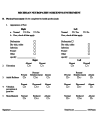Diabetic Foot Care Education and Practices: A Knowledge, Attitudes, and Practices Questionnaire-Based Study
- PMID: 40625462
- PMCID: PMC12229823
- DOI: 10.7759/cureus.85436
Diabetic Foot Care Education and Practices: A Knowledge, Attitudes, and Practices Questionnaire-Based Study
Abstract
Background Diabetic foot disease is a significant cause of morbidity among individuals with diabetes and can be effectively prevented with proper patient education early in the disease course. This study was conducted with the aim of assessing the knowledge, attitudes, and practices of diabetic patients toward foot care, as well as estimating the prevalence of diabetic foot disease. Methods A cross-sectional study was conducted among 128 diagnosed patients with diabetes, using a structured questionnaire and the Michigan Neuropathy Screening Instrument (MNSI) parts A and B, at a referral hospital in Central India. The questionnaire included questions about foot care practices, knowledge of diabetic foot complications, and attitudes toward foot care. The MNSI was used to screen for neuropathic symptoms and signs indicative of diabetic foot disease. Results Among the participants, 110 out of 128 (85.9%) reported that they had never received any education from their healthcare provider regarding proper foot care practices. Almost one-fourth of our participants, accounting for 95 (74.2%) of them, lacked adequate knowledge about maintaining proper foot hygiene, and 78 (60.9%) were unaware of the foot-related complications associated with diabetes. The study found a significant positive association between knowledge scores and the duration of diabetes. Despite the lack of knowledge, 125 (97%) of the patients demonstrated a positive attitude and expressed a willingness to adopt proper practices when educated. Notably, 52 (40.6%) of the participants walked barefoot, and 116 (90.6%) did not undergo annual foot examinations. Diabetic foot disease was identified in 40 out of 128 (31.3%) participants based on abnormal MNSI scores. There was a significant positive correlation between the duration of diabetes and the presence of diabetic foot disease. Higher MNSI score A was associated with poorly controlled diabetes, highlighting the impact of glycemic control on neuropathic symptoms. The presence of diabetic foot disease was also significantly associated with macroalbuminuria. Conclusion Our study revealed substantial deficiencies in the education of diabetic patients concerning foot care practices. The prevalent positive attitude among the patients indicates that diabetic foot disease can be effectively prevented with adequate patient education and proactive care by primary healthcare providers. Addressing these deficiencies in awareness and practice is essential for improving patient outcomes and preventing severe complications associated with diabetic foot disease.
Keywords: diabetic foot disease; diabetic foot ulcer; kap for diabetic foot; michigan neuropath screening instrument; peripheral neuropathy.
Copyright © 2025, Singh et al.
Conflict of interest statement
Human subjects: Consent for treatment and open access publication was obtained or waived by all participants in this study. Institute Ethics Committee, All India Institute of Medical Sciences, Raipur issued approval AIIMSRPR/IEC/2022/1254. Animal subjects: All authors have confirmed that this study did not involve animal subjects or tissue. Conflicts of interest: In compliance with the ICMJE uniform disclosure form, all authors declare the following: Payment/services info: All authors have declared that no financial support was received from any organization for the submitted work. Financial relationships: All authors have declared that they have no financial relationships at present or within the previous three years with any organizations that might have an interest in the submitted work. Other relationships: All authors have declared that there are no other relationships or activities that could appear to have influenced the submitted work.
Figures



Similar articles
-
Awareness of long-term foot complications in people living with diabetes mellitus in Mauritius: a cross-sectional study.Pan Afr Med J. 2025 Jun 10;51:40. doi: 10.11604/pamj.2025.51.40.47476. eCollection 2025. Pan Afr Med J. 2025. PMID: 40776998 Free PMC article.
-
Signs and symptoms to determine if a patient presenting in primary care or hospital outpatient settings has COVID-19.Cochrane Database Syst Rev. 2022 May 20;5(5):CD013665. doi: 10.1002/14651858.CD013665.pub3. Cochrane Database Syst Rev. 2022. PMID: 35593186 Free PMC article.
-
Topical antimicrobial agents for treating foot ulcers in people with diabetes.Cochrane Database Syst Rev. 2017 Jun 14;6(6):CD011038. doi: 10.1002/14651858.CD011038.pub2. Cochrane Database Syst Rev. 2017. PMID: 28613416 Free PMC article.
-
Interventions for patients and caregivers to improve knowledge of sickle cell disease and recognition of its related complications.Cochrane Database Syst Rev. 2016 Oct 6;10(10):CD011175. doi: 10.1002/14651858.CD011175.pub2. Cochrane Database Syst Rev. 2016. PMID: 27711980 Free PMC article.
-
Psychological interventions for treating foot ulcers, and preventing their recurrence, in people with diabetes.Cochrane Database Syst Rev. 2021 Feb 8;2(2):CD012835. doi: 10.1002/14651858.CD012835.pub2. Cochrane Database Syst Rev. 2021. PMID: 35653236 Free PMC article.
References
-
- International Diabetes Federation. Diabetes facts and figures. [ May; 2025 ]. 2025. https://idf.org/about-diabetes/diabetes-facts-figures/ https://idf.org/about-diabetes/diabetes-facts-figures/
-
- Spectrum of diabetic neuropathy: new insights in diagnosis and treatment. Dillon BR, Ang L, Pop-Busui R. Annu Rev Med. 2024;75:293–306. - PubMed
-
- U.K. Prospective Diabetes Study 22. Effect of age at diagnosis on diabetic tissue damage during the first 6 years of NIDDM. Davis TM, Stratton IM, Fox CJ, Holman RR, Turner RC. Diabetes Care. 1997;20:1435–1441. - PubMed
-
- Global disability burdens of diabetes-related lower-extremity complications in 1990 and 2016. Zhang Y, Lazzarini PA, McPhail SM, van Netten JJ, Armstrong DG, Pacella RE. Diabetes Care. 2020;43:964–974. - PubMed
LinkOut - more resources
Full Text Sources
